
UTA utilizes IPCS (Integrated Project Controls System) to manage all formal correspondence on a project. IPCS handles project information such as Deliverables, Quality documentation, Requests for Information (RFI), Transmittals, Risk, Budget, Schedules, Project Issues and Project Team information. This training focuses on the Deliverables Module within IPCS. For more information on the other areas of IPCS, reference the contents to the left.
The deliverables module provides a structured workflow for the process of various submittals, RFIs, and Transmittals. IPCS is the master record of all project deliverables and tracks these deliverables through the initial submittal, comments resolution, and submittal of final contract documents.
UTA Project Managers (PM) will request IPCS logins for contractors working on their projects. Gregg Larson (as of May 2016) at UTA grants new logins. Contact him at GLarsen@rideuta.com if you have any questions about access. Once you’ve been granted access, the URL is https://ipcs.rideuta.com/IPCS Be sure to use the "Contractor Login" link shown on the login page. This is the direct link to the contractor login page: https://ipcs.rideuta.com/IPCS/Web/Authentication/ExtLogin.aspx
Once you’ve logged in, you should see your project in the Project Listing:

Click the project code hyper-link to enter your project and find the Deliverables menu item in the top right as seen below in Red

Any documentation requiring formal review and/or acknowledgment of receipt is handled as a Deliverable in IPCS. Materials Testing and Systems Testing documentation are handled through the "Quality" Module on IPCS.
When a Contractor needs to submit a document via IPCS, they will create a new Deliverable. Each Deliverable may have several sub-items called "Action Items". These Action Items handle the formal iterations of a submitted document. For example, the first time a document is submitted for review, Action Item 001 is automatically created for that Deliverable. If UTA responds and has comments that require a resubmittal, Action Item 002 would then be created by the contractor under the same Deliverable, and contractor would submit revised document for another review by UTA.
Selecting the "Deliverables" button will display the Deliverables Dashboard. Here you will find a high-level overview of the status of all project submittals. If you have access to more than one contract on a project, the tabs across the top list the various contracts that you have access to.

Clicking a linked number will show detailed information for that value.
The deliverables listing page can be found by clicking on "All Submittals" or by clicking on the pre-filtered options which include "Design Submittals", "Product Submittals", or "Project Management Submittals". There is also an option to view and create "RFIs", and "Transmittals." The deliverables listing page has a similar tabbed appearance to the dashboard: the tabs across the top indicate which contracts a contractor has access to. If the tab has a faded name, then there are no visible deliverables for that contract.

The Deliverables List is a grid of key deliverable properties helpful for finding submittals based on ID, importance, resolution, or other field.
You may filter and sort the Deliverables list in many different ways to help navigate a project with several Deliverables. Sorting is done by clicking on the column headers of the Deliverables list. Sorting in this way allows the list to be viewed A-Z or Z-A, much list sorting in an Excel spreadsheet.
IPCS currently has two sets of filters available:
1. Dropdown/free text filters that filter by Deliverable attributes such as Title, Type, Originator, Assigned to, etc.
2. Action Taken Filters (check boxes)- This allows a user to filter Deliverables by the action taken on the most recent Action item of a Deliverable
Clicking the "ID", "Title", or "View" links will allow you to see the contents of a Deliverable.
The "Open Items" link navigates to a list of the deliverable action items which remain open. The "+" icon will expand a specific Deliverable and show all associated action items for that Deliverable.
There are also Expand All and Collapse All shortcut links that will expand/collapse all Deliverable Action item details, which is also useful for scanning the entire list details without having to navigate off the screen.

Finally, at the top and bottom of this page are "New Submittal" buttons, used for creating a brand new record. These buttons may change text slightly when viewing RFIs or Transmittals to "Create RFI" and "Create Transmittal", respectively.
To create a new Deliverable click on the "Deliverables" menu item as shown below, then click on "All Submittals" (or RFIs, or Transmittals if you wish to create a new RFI or Transmittal):

Next, click on the "New Submittal" button as shown below:
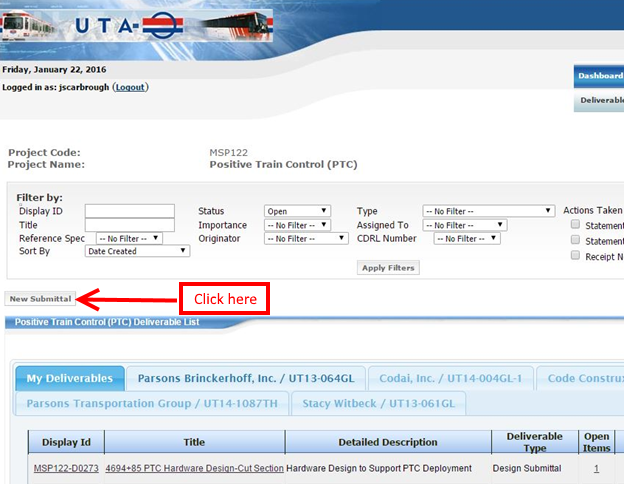
The following screen will appear after selecting "New Submittal":
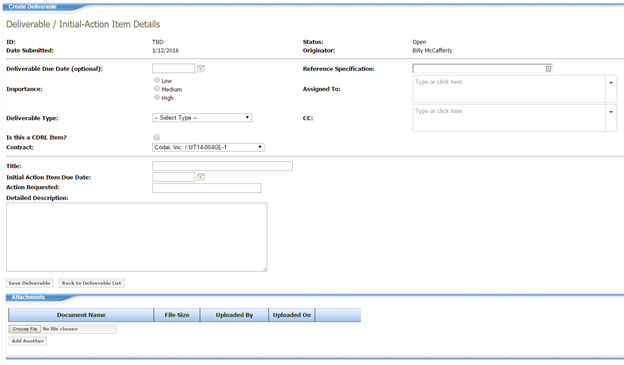
This screen contains all the input fields that a new deliverable needs. Remember that when you create a new Deliverable, the first action item is created automatically. The deliverable title format should be decided upon at the beginning of the project to ensure consistency. This is a policy the UTA Deliverables Administrator will set. It’s important to use good judgement so an issue can be searched and retrieved in the future, if needed.
The available deliverable type options are:
Importance must be selected prior to saving the Deliverable.
If the document being submitted is on the Contract Document Required List (CDRL) you should check the box titled "CDRL". Once that box is selected a new text field will appear where the CDRL number can be entered. If the document being submitted is required by a section within the Project Specification, you may type in the referenced specification section in the "Reference Specification" field. Please confirm with the UTA Deliverables Administrator for your project to determine if this field should be used.
You must select at least one person in the "Assigned To:" field. People in the "Assigned to" field should be the individual or individuals whose review is requested for the submitted documentation. If you would like to have someone informed that a particular Deliverable have been created and responded to, add them in the "CC" field. Those in the "Assigned to" or "CC" fields will always show up in all automated email correspondence throughout the life of a particular Deliverable.
In most scenarios, the Assigned To / Reviewers should be the UTA employee(s) or other identified stakeholders that need to review the deliverable. If the contractor would like someone on their end to be kept in the loop, the originator should add that person in the CC field.
To expedite the process of adding individuals in the "Assigned to" and "CC" lists, you may create an email Distribution List in IPCS. This is helpful if you will be submitting several Deliverables throughout the life of a project that need to be reviewed or viewed by the same group of people. Distributions lists may be created by Clicking on the "Project Team" button, then clicking on "Distribution Lists" as shown below:
You may then select "New Distribution List" as shown in the figure below and begin adding email address to the new list. You will also name the newly created distribution list. When you then want to use the Distribution List in the "Assigned to" or "CC" fields of Deliverables, start typing the name of the Distribution List and it will show up in the list of suggested names. Distribution Lists are project specific, meaning if you create one in a particular project in IPCS, it won’t show up on everyone else’s projects.
The originator of a deliverable should include sufficient information in the Detailed Description to enable anyone viewing the deliverable to know what the deliverable is, and what action is being requested. As well as any other pertinent or unique information to the deliverable that would be necessary for an efficient and thorough review.
If you have not filled in all the required fields, you will receive a Red error message at the top of the page informing you about what information is missing. Once you have filled out the required fields, you will be prompted with the following screen:
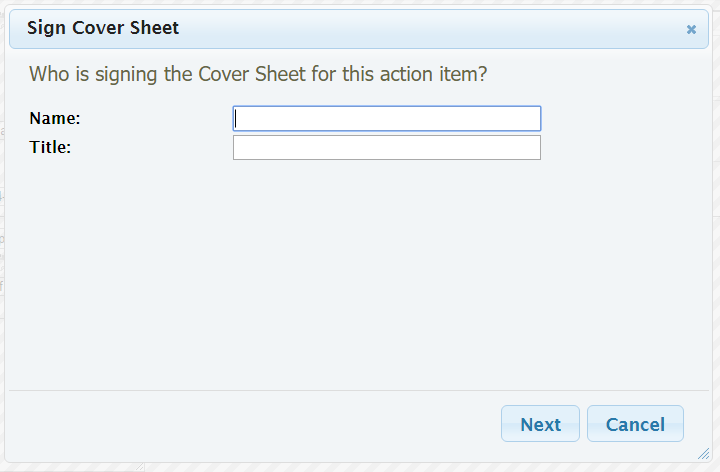
Make sure you fill in your name (contractor's representative) and title. If you’re unsure whose name should be entered here, please check with the UTA Deliverables Administrator for your project.
You will then be asked if you want to automatically generate and attach the Comment Resolution Form. This form is now superseded by a digital representation in the Review Comments section. Review Comments details can be found in the next section in this document. Most likely, the XLS document will not be used for tracking comments on your project.
If at any time a hard-copy of the CRF is needed, there is a button to do so on the View Deliverable screen titled "Export Comments to XLS". Nearly all new projects will utilize the latest review comments feature within IPCS. If you need to extract the comments stored within IPCS, a CRF can be generated that contains existing comments from IPCS.
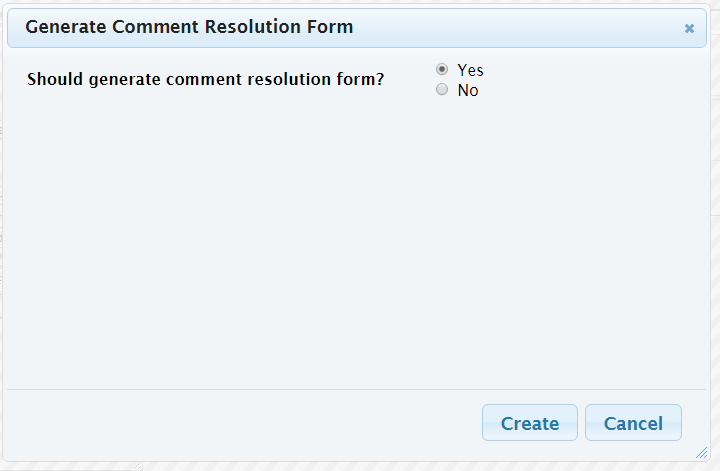
Upon clicking Create, the system will save your submittal and you’ll see a screen like the following:
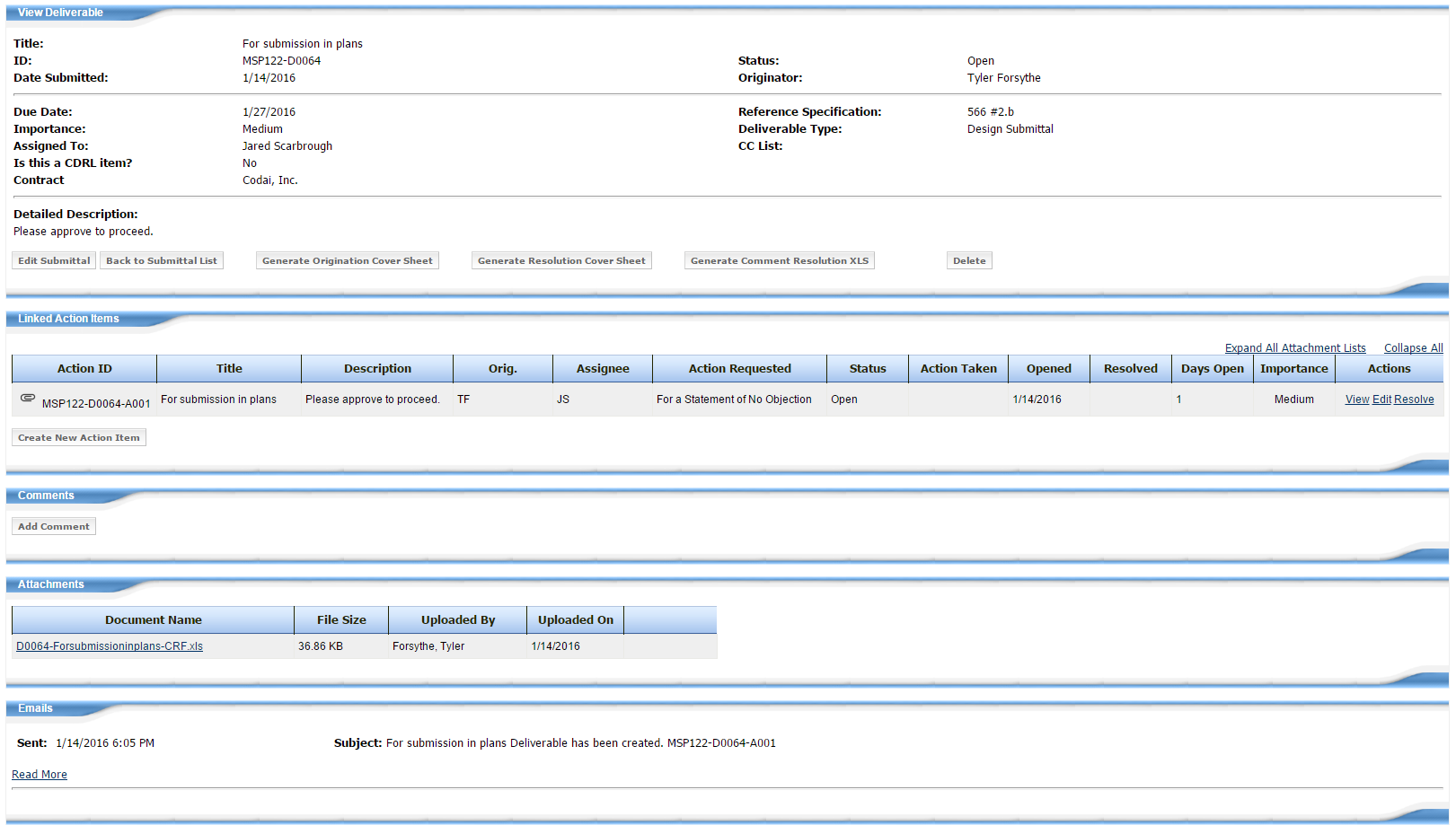
The summary information is at the top and an action item has automatically been created. If you instructed the system to generate an excel version of the comment resolution form, it will be attached to the Deliverable (not the Action Item) and look like the following:
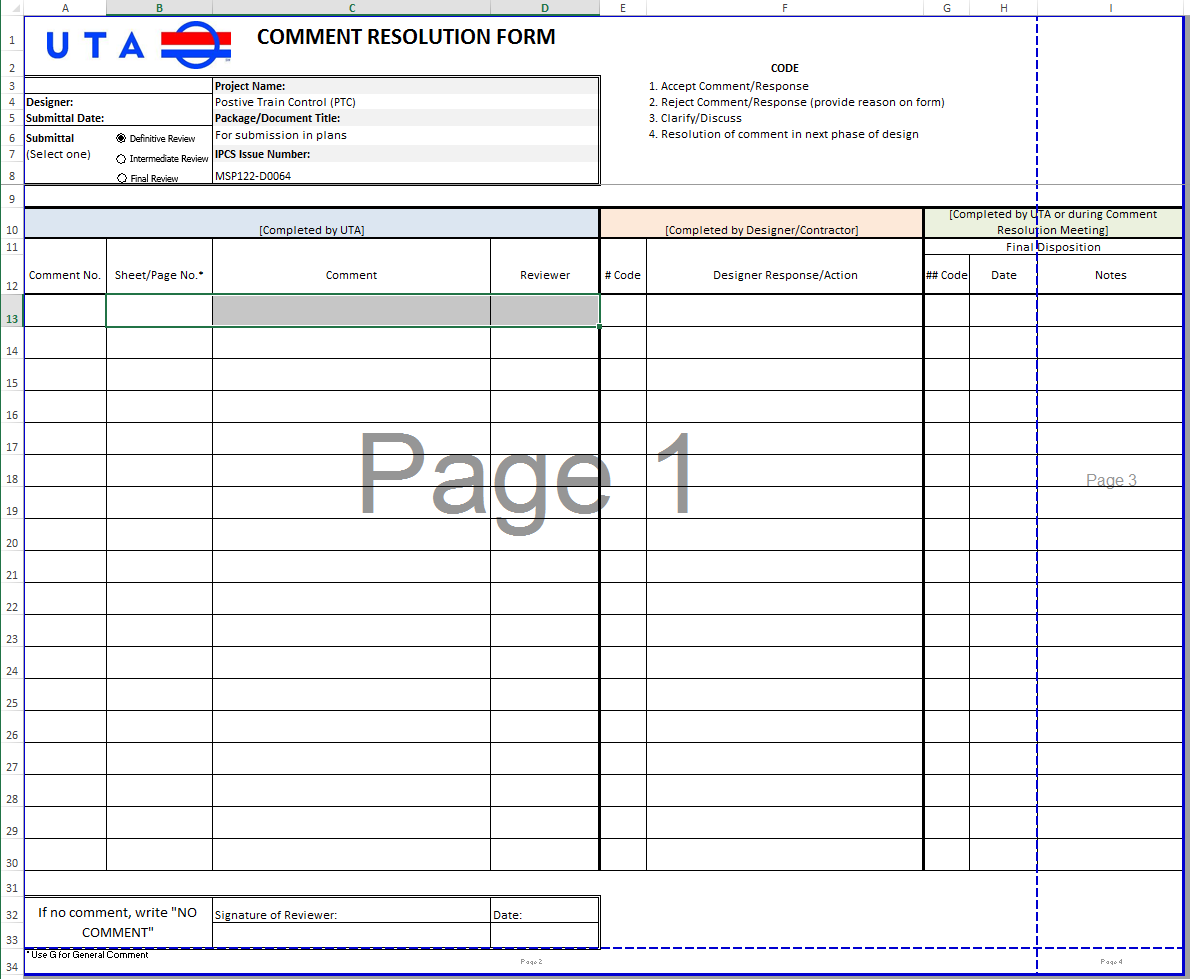
Note again that this XLS document is superseded by the Review Comments section, which is described in detail below in the next section.
Finally, an email will have automatically been sent. See the "Email Notifications" section for a sample.
The preferred method of managing review comments is by using an embedded version of the Comment Resolution Form XLS shown above. It is optional because the deliverable workflow will function the same even without any review comments entered.
Review comments may be added by a contractor or UTA personnel. Typical workflow for these comments is for the deliverable reviewer, usually UTA, to create comments in the blue section. Once the current action item is approved resolved, the comments will become available for contractors to see and respond. Contractors respond in the peach section. Finally, UTA reviewers may review the contractor's feedback and give final disposition in the green fields.
A contractor may create a review comment in the blue and then immediately respond in the peach fields.
The "Send Review Status Email" button sends an email to all reviewers notifying them that the current user has completed their comments. However, this button is not required to be clicked. When the email has been sent, a confirmation message will display to let you know that it was successful.
When a deliverable is first created, a default action item is automatically created and populated based upon the details entered for the deliverable. If a new action item is needed for a Deliverable (for example, when an document was commented on by UTA and requested to be resubmitted) the new Action Item may be created from either the Create or View Deliverable screens by clicking "Create New Action Item" in the "Linked Action Items" section.
The following screen will then appear prompting you to fill in information about this new Action Item such as Due Date, Assigned to, CC List, Title, Description, Action Requested and the ability to attach a new document to this action item.
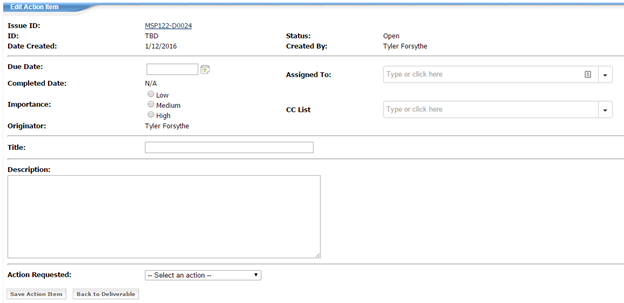
Once sufficient review has been completed, a deliverable is to be proposed to the UTA PM for resolution. Resolution of a deliverable should only be proposed by individuals intimately familiar with the deliverable and IPCS workflow process. It is recommended that project specific discussion be had about who expressly should be empowered to proposed deliverable for resolution. In most cases, this will be the UTA Deliverable Administrator. Although other UTA staff or empowered individuals from other stakeholders may also be in the appropriate position to propose resolutions for certain deliverable.
To resolve an action item, you may click Resolve from either the deliverable "Linked Action Items" listing actions column:

Or from the action item detail screen itself:
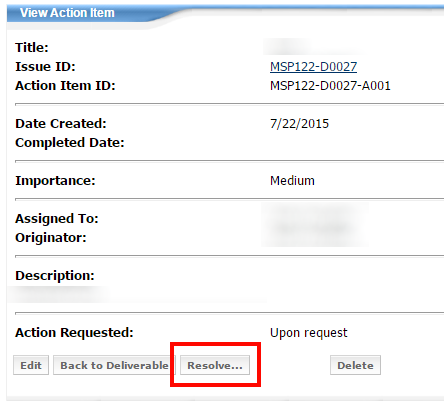
You will need to respond to 3 prompts during the Action Item Resolution process:
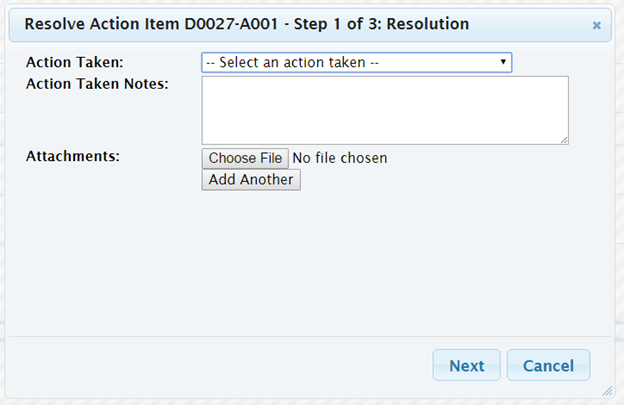
The action taken, to be selected from available options, and any additional notes or attachments associated with that action.

Step 2 is who else is to be notified. By default, the Originator and Assigned To users will be emailed, as well as anyone in the CC listing. Here you may add other email addresses that should be copied on the resolution email. This email will not send until after the PM has approved the resolution.
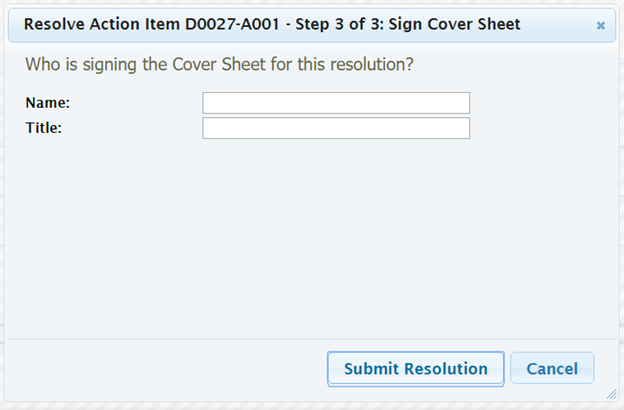
Finally, the system will prompt for the name and title of the person submitting the resolution. The system will auto-populate with the name and title of the UTA Project Manager, but may be changed on a case by case basis. If you’re unsure what to enter, please see your UTA Deliverables Administrator. Once everything is entered, click Submit Resolution.
Upon completion of this resolution, the status becomes "pending" and the ball in court moves to the PM. Note again that no resolution emails will send until the PM has approved the action item.
After resolution for a deliverable has been approved by use of the Resolve hotlink, the status becomes Pending and awaits approval from the project manager. When viewing the project Dashboard, the Project Manager will see a PM Task List of all pending action items and their status. This makes it easy for the PM to see all items pending approval and handle them all at once. The PM may choose to Approve, Return to Reviewer, or take no action on any of the pending action items, then click "Process All" to batch-update them.

If the PM selects "Return to Reviewer", the user who resolved the action item will receive an email about the status change, and the pending resolution will be cleared. Additionally, there is a space for the PM to enter comments for each deliverable that is to be returned. The field is not large and not meant to accommodate a lengthy explanation, but can be used for small notes or instructing the reviewer to see look at additional documentation.
If the PM selects "Approve", emails will be sent to all parties on the action item showing the status change and the action item disposition becomes final. If "No Action" is selected, nothing will happen to the deliverable and it will remain on the PM’s task list.
Until a PM completes this final approval, the action item will stay in the Pending status. It’s important for PMs to approve pending items regularly to prevent holding up other tasks. Every morning around 4:30am, the IPCS system will send a reminder email to all PMs containing a list of all pending resolutions needing their approval.
If there are any Review Comments entered by UTA, they will become visible to contractors only after the PM approves the latest disposition.
When a deliverable is created, an "Origination coversheet" is automatically generated and saved to the Action Item just created. This documents in a printer-friendly format the exact state of the deliverable at conception. Upon resolution, a similar looking document called a "Resolution coversheet" is created for the Action resolved that documents the final action to be taken as well as the whole action item history.
A typical resolution coversheet example is below:
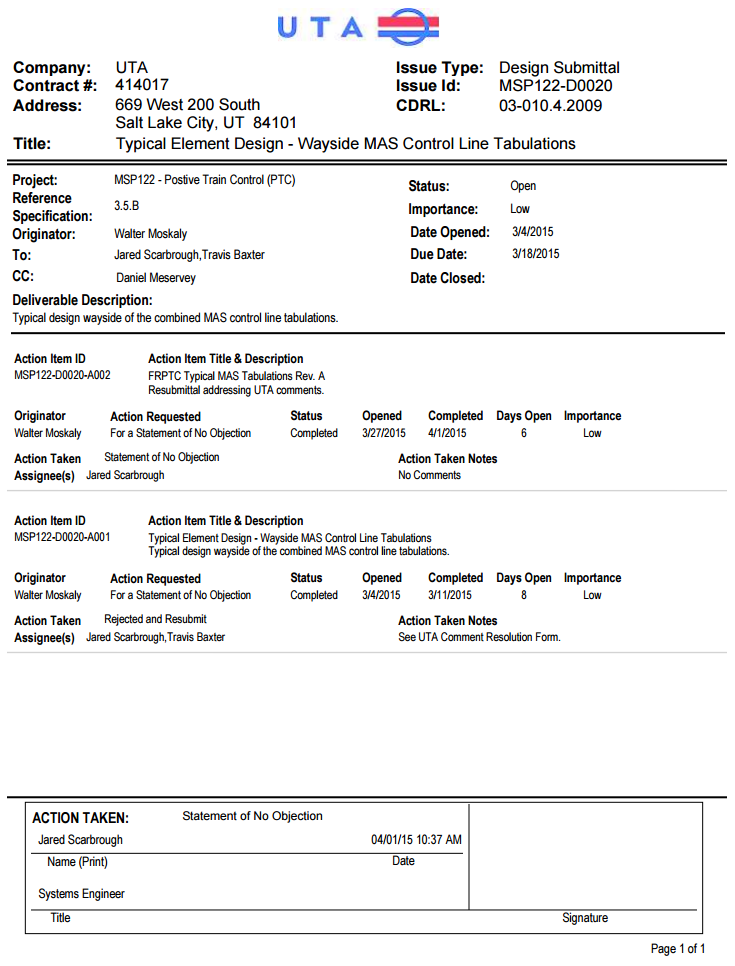
Email notifications regarding deliverables are sent to identified parties anytime a Deliverable is created, an attachment is added, a comment is added, when a new Action Item on an existing Deliverable is created, or when an Action Item is resolved. These email recipients are those in the "Assigned To" field and the "CC List" field as filled out during the Deliverable/Action Item creation. Anyone may be added to the email list of a particular Deliverable if they are added to the "Additional Recipients" field in Step 2 of the Deliverable Response Dialog box.
All emails follow the same format. They are broken in sections of What, When, Who, and Why. The "What" shows title, description, Deliverable Type, CDRL, and Specification Section. "When" shows important dates such as date created, due date, and importance. "Who" indicates who created the Deliverable, who it’s assigned to, and CC individuals. Finally, the "Why" shows the action requested and action taken (if the Action Item has been resolved).
At the very bottom of the email will be a link to take you directly to the created or updated item.
Additionally, when a Deliverable or Action Item has changed, the values that have changed will be in italics and proceeded with double asterisk (**).
When a submittal is created, the following email is automatically generated:
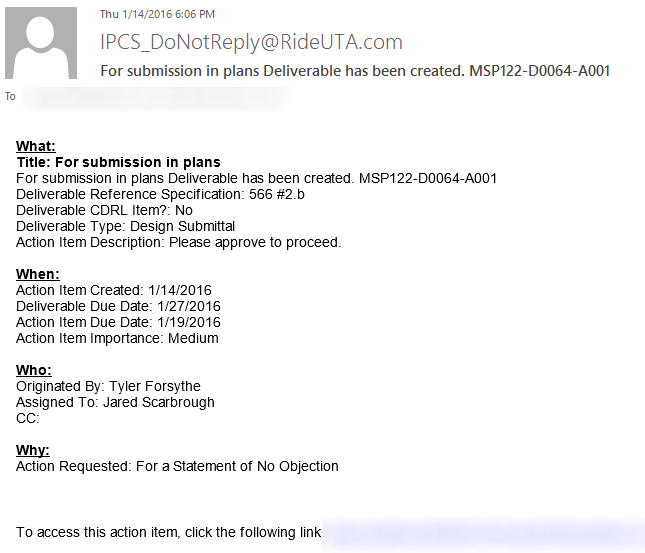
Example 1- UTA Rejects (or SNO w/ Comments) a Submittal using Comment Review System:
Step 1: D0001-A001- Contractor Submits a new IFR drawing set for review without generating a CRF.
Step 2: UTA Reviews A001, fills out the Deliverable Review Comments blue section and Rejects submittal.
Step 3: Contractor responds to Deliverable Review Comments in the peach section.
Step 4: UTA reviewers finalize contractor’s response in the green section of Deliverable Review Comments.
Step 5: D0001-A002 is then created by Contractor after they have addressed all comments. Contractor ATTACHES NEW DOCUMENTATION WITH ALL COMMENTS ADDRESSED TO A002.
Step 6: As long as all comments were addressed in Step 3, UTA gives a SNO.
Example 2- UTA Rejects (or SNO w/ Comments) a Submittal:
Step 1: D0001-A001- Contractor Submits a new IFR drawing set for review and tells IPCS to generate a blank CRF.
Step 2: UTA Reviews A001, fills out the CRF and Rejects submittal, fills out the Review Comment section of the Deliverable (or attaches excel CRF) to UTA’s IPCS response to A001.
Step 3: D0001-A002 is then created by Contractor after they have addressed comments from Step 2. Contractor Fills out CRF (Columns E and F on the .xls file), and ATTACHES NEW DOCUMENTATION WITH ALL COMMENTS ADDRESSED AND THE COMPLETED CRF TO A002. (No need to create a new action item with just a CRF.)
Step 4: As long as all comments were addressed in Step 3, UTA gives a SNO if drawings in Step 3 were IFR, or a Receipt Noted if drawings in Step 3 were an IFC. See Note 1 Below.
Example 3- UTA has no comments on Submittal:
Step 1: D0001-A001- Contractor Submits a new submittal for review and tells IPCS to generate a blank CRF.
Step 2: UTA Reviews A001, finds no issues with submittal, responds to IPCS as SNO, no CRF is attached.
Step 3: D0001-A002 is then created by Contractor, contractor attaches IFC drawings to A002 for "Project Records".
Step 4: UTA gives a "Receipt Noted" on the IFC drawings from step 3 (A002). Submittal is completed until AIS.
Note 1: In Example 1 above, UTA is okay on this project to advance the drawings in step 3 up to the next phase. For example; if you submitted an IFR drawing in Step 1, and we comment and have things that need to be corrected, when you resubmit in Step 3, we are okay with you advancing to IFC, so long as all the comments are addressed. If by some chance we still find something wrong with IFC we will reject, otherwise we will accept the design and the process is complete. We think this will eliminate the intermediate step of resubmitting an IFR drawing in step 3, then having to submit yet another IFC after that.